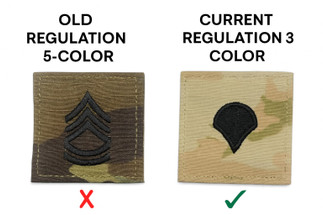Posted by Case Smien on 19th Sep 2025
Why Do Some OCP Ranks Look Lighter or Darker? (3-Color vs 5-Color Explained)
If you’ve ever looked down at your uniform and thought, “Why doesn’t my rank patch match my OCP top?” — or stood in a surplus store holding two different patches, one lighter and one darker, wondering which one is right — you’re not alone. This is one of the most common frustrations Soldiers share with us at Military Depot. "WE WANT A PERFECT MATCH!!!"
Well, your perfect match might not be in regs...
Some patches look lighter, while others appear darker and blend in more. Both have been seen in use, but only one is technically the correct, authorized option.
The Two Types of OCP Rank Patches
What most Soldiers notice as “light vs dark” actually comes down to how many thread colors are used in the patch background:
3-Color OCP Ranks (lighter look, current regulation standard):
Made with three thread shades. These are the true regulation-standard ranks authorized by the Army, Air Force, and Space Force. Because they use fewer thread colors, they often appear lighter or more subdued compared to the darker fabric panels of your OCP top.
5-Color OCP Ranks (darker look, old standard - no longer authorized):
Made with five thread shades. The extra colors create a darker background that blends better with certain areas of the uniform. However, 5-color ranks are generally no longer authorized by the Army, Air Force, or Space Force. While some Soldiers still buy them for the darker look, they’re technically not correct — even if enforcement is usually very light.
Why the Switch to 3-Color?
When OCP (Scorpion W2) uniforms were first issued, 5-color rank patches were the standard because they matched the 5-color camouflage of the uniform itself. That match looked great — but it created a practical problem.
- The darker 5-color patches blended in too well, making it harder to quickly identify rank in the field or during inspections.
- The lighter 3-color patches provide better contrast and visibility while still blending appropriately with OCP.
Result: the services adopted the 3-color patch as the authorized standard. Many Soldiers still prefer the darker look, but visibility and consistency drove the change.
Which One Should You Choose?
- If you want to stay fully in regs → choose the 3-color patch.
- If you’re extremely detail-oriented and want your rank to “match” darker panels → you may be tempted to pick the 5-color patch, but keep in mind, while it may not be strictly enforced by your leadership it is still not officially correct anymore.
At the end of the day, 3-color ranks are the safe choice for inspection, boards, and regulation compliance.
Why It Never Matches 100%
Even if you go with the darker 5-color, your patch won’t perfectly blend into every area of the uniform. OCP tops are sewn from multiple fabric panels with natural shade variation. Some areas are darker, some are lighter — so no patch will ever look identical across the entire uniform.
Shop the Right Patch for You
At Military Depot, we carry both 3-color (authorized) and 5-color (darker) OCP ranks. Whether you want to stay strictly regulation or you just can’t stand the lighter look, we make sure you have the choice.
Bottom Line
When Soldiers ask, “Why does my OCP rank look lighter than my uniform?” — the answer is simple: it’s the difference between 3-color and 5-color OCP ranks. Both are available, but the 3-color is the true, authorized version. The 5-color is technically no longer authorized by the Army, Air Force, and Space Force, though some still wear it because they prefer the darker look.
At Military Depot, we may show you both options in store so you can see the difference, but when it comes to shipping, we will always send you the proper, regulation-authorized product. Every piece of insignia we manufacture is Made in the USA to TIOH (The Institute of Heraldry) standards, so you can shop with confidence knowing your rank is correct, durable, and inspection-ready.

